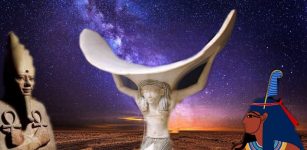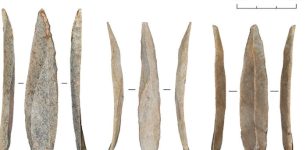What Is The Curse Of The Ninth Symphony?
Conny Waters - AncientPages.com - If you enjoy classical music, you may have heard about the curse of the ninth symphony. It’s an old belief that makes some think a composer will die after completing his ninth symphony. But how and why did this belief spread?
It turns out that the curse of the ninth symphony can be traced to Ludwig van Beethoven, a German composer, and pianist. When Beethoven died in 1827, he had completed nine symphonies. He started working on his tenth musical work but could not finish it because he died.
Beethoven was one of many composers who died after finishing their ninth symphony. Image credit: Public Domain
It’s not unusual that an artist or musician dies before he or she can finish their masterpiece, but Beethoven was not the only composer who left this world after completing the ninth symphony.
An Austrian composer, Anton Bruckner (1824 – 1896) died before he finished his ninth symphony.
From the New World, a famous symphony was the ninth and last musical work written by Antonín Dvořák (1841 – 1904), a Czech composer.
Gustav Mahler (1860 1911), a late-Romantic Austrian composer, started to panic when he noticed that so many had died after writing their ninth symphony. He became convinced the ninth symphony must be cursed. Desperately trying to avoid the curse, he cheated. Mahler wrote a musical piece called Das Lied von der Erde, but though it was a symphony, he refused to call it so.
In the book Gustav Mahler: The Symphonies, author Constantin Floros writes that Mahler “did not dare to call it a symphony because he had an outright, superstitious “fear of the idea of the Ninth Symphony.” He firmly held to the superstition “that no great symphonic writer was to live beyond his Ninth.”
Mahler believed that he had fooled the curse and started working on symphony no. 9, though it was his tenth work. However, higher powers had other plans for him. Mahler died while working on his tenth symphony.
Those who believe in the curse of the ninth symphony say that other composers such as Kurt Atterberg, Elie Siegmeister, Alfred Schnittke, Roger Sessions, Egon Wellesz, Ralph Vaughan Williams, Peter Mennin, Malcolm Arnold, and David Maslanka all died before they could begin working on their tenth symphony.
Arnold Schoenberg (1874 -1951), an Austrian-American composer, once expressed his concern by saying that “it seems that the Ninth is a limit. He who wants to go beyond it must pass away. It seems as if something might be imparted to us in the Tenth which we ought not yet to know, for which we are not ready. Those who have written a Ninth stood too close to the hereafter.”
Is the curse of the ninth symphony just a coincidence? Some say yes, and those who are more superstitious think something sinister is at work here. As mentioned earlier on Ancient Pages, many ancient cultures regarded the number 9 (or ‘Nine’) as a symbol of perfection, unity, and freedom. Still, there is no evidence our ancestors associated the number nine with curses.
Still, in modern times, it’s no wonder that whenever a composer is writing his 10th symphony, he is a little worried. Many say the curse is foolish, but they are nevertheless a little frightening.
Updated on July 10, 2022
Written by Conny Waters - AncientPages.com Staff
Copyright © AncientPages.com All rights reserved. This material may not be published, broadcast, rewritten or redistributed in whole or part without the express written permission of AncientPages.com
Expand for referencesJoanne O'Sullivan - Book of Superstitious Stuff
More From Ancient Pages
-
 Ancient Town’s Destruction Dated With Help Of Chicken Bones And Snail Shells
Archaeology | Aug 17, 2022
Ancient Town’s Destruction Dated With Help Of Chicken Bones And Snail Shells
Archaeology | Aug 17, 2022 -
 1,500-Year-Old Christian Reliquary Found In An Unknown Church In Irschen, Austria
Archaeology | Jun 26, 2024
1,500-Year-Old Christian Reliquary Found In An Unknown Church In Irschen, Austria
Archaeology | Jun 26, 2024 -
 Mystery Of Nebra Sky Disk: New Analysis Shows Surprising Results
Artifacts | Sep 4, 2020
Mystery Of Nebra Sky Disk: New Analysis Shows Surprising Results
Artifacts | Sep 4, 2020 -
 Traces Of Ancient Near East Civilization In America – An Out-Of-Place Ancient Inscription – Part 2
Ancient Mysteries | Nov 13, 2020
Traces Of Ancient Near East Civilization In America – An Out-Of-Place Ancient Inscription – Part 2
Ancient Mysteries | Nov 13, 2020 -
 Paleolithic Workshop Unearthed In The İnkaya Cave In The Turkish Western Province Of Çanakkale
Archaeology | Oct 29, 2022
Paleolithic Workshop Unearthed In The İnkaya Cave In The Turkish Western Province Of Çanakkale
Archaeology | Oct 29, 2022 -
 Beethoven’s Genome Offers Clues To Composer’s Health And Family History
DNA | Mar 27, 2023
Beethoven’s Genome Offers Clues To Composer’s Health And Family History
DNA | Mar 27, 2023 -
 Sobek: A 2,500-Year-Old Mummified Nile Crocodile – On Display At The British Museum
Archaeology | Dec 9, 2015
Sobek: A 2,500-Year-Old Mummified Nile Crocodile – On Display At The British Museum
Archaeology | Dec 9, 2015 -
 Stribog – Slavic God Of Winds Associated With Destruction, Harvest, Evil And Good
Featured Stories | Jul 1, 2019
Stribog – Slavic God Of Winds Associated With Destruction, Harvest, Evil And Good
Featured Stories | Jul 1, 2019 -
 The Colored Skeletons Of 9000-Year-Old Çatalhöyük (Catalhoyuk), Turkey – New Examination
Archaeology | Mar 18, 2022
The Colored Skeletons Of 9000-Year-Old Çatalhöyük (Catalhoyuk), Turkey – New Examination
Archaeology | Mar 18, 2022 -
 Hidden Connection Between The Zodiac, Ancient Egypt, Freemasonry And Christianity
Ancient Mysteries | Aug 14, 2018
Hidden Connection Between The Zodiac, Ancient Egypt, Freemasonry And Christianity
Ancient Mysteries | Aug 14, 2018 -
 Shu: Egyptian God Of Air, Symbol Of Life-Giving Breath And The One Who Separates Heaven From Earth
Egyptian Mythology | Oct 23, 2020
Shu: Egyptian God Of Air, Symbol Of Life-Giving Breath And The One Who Separates Heaven From Earth
Egyptian Mythology | Oct 23, 2020 -
 War Between Romans And Persians Lasted 721 Years: One Of The World’s Longest Human Conflicts In History
Featured Stories | Apr 18, 2022
War Between Romans And Persians Lasted 721 Years: One Of The World’s Longest Human Conflicts In History
Featured Stories | Apr 18, 2022 -
 Laocoon – A Trojan Priest Who Offended The Gods And Was Strangled By Sea Serpents
Featured Stories | Nov 15, 2021
Laocoon – A Trojan Priest Who Offended The Gods And Was Strangled By Sea Serpents
Featured Stories | Nov 15, 2021 -
 Ancient Bizarre Experiments Conducted In Mysterious Underground Temple
Ancient Mysteries | Jun 28, 2018
Ancient Bizarre Experiments Conducted In Mysterious Underground Temple
Ancient Mysteries | Jun 28, 2018 -
 Prehistoric ‘Cinema’ – Unique Karelian Rock Carvings With Special Light Effects
Featured Stories | Jul 14, 2014
Prehistoric ‘Cinema’ – Unique Karelian Rock Carvings With Special Light Effects
Featured Stories | Jul 14, 2014 -
 Jeanne de Clisson ‘Lioness Of Bretagne’: Her Black Painted Ships With Red Sails Terrorized English Channel
Featured Stories | Oct 4, 2019
Jeanne de Clisson ‘Lioness Of Bretagne’: Her Black Painted Ships With Red Sails Terrorized English Channel
Featured Stories | Oct 4, 2019 -
 On This Day In History: Statue of Liberty Arrived In New York Harbor – On June 17, 1885
News | Jun 17, 2016
On This Day In History: Statue of Liberty Arrived In New York Harbor – On June 17, 1885
News | Jun 17, 2016 -
 Hidden Silver Casket With Bones Of 13th Century Saint Found
Archaeology | Mar 22, 2020
Hidden Silver Casket With Bones Of 13th Century Saint Found
Archaeology | Mar 22, 2020 -
 ‘Exceptionally’ Rare Iron Age Axle Found In Suffolk
Archaeology | Jan 26, 2023
‘Exceptionally’ Rare Iron Age Axle Found In Suffolk
Archaeology | Jan 26, 2023 -
 Mass Production Of Stone Bladelets Led To A Cultural Shift In Paleolithic Levant
Archaeology | Jan 7, 2023
Mass Production Of Stone Bladelets Led To A Cultural Shift In Paleolithic Levant
Archaeology | Jan 7, 2023


